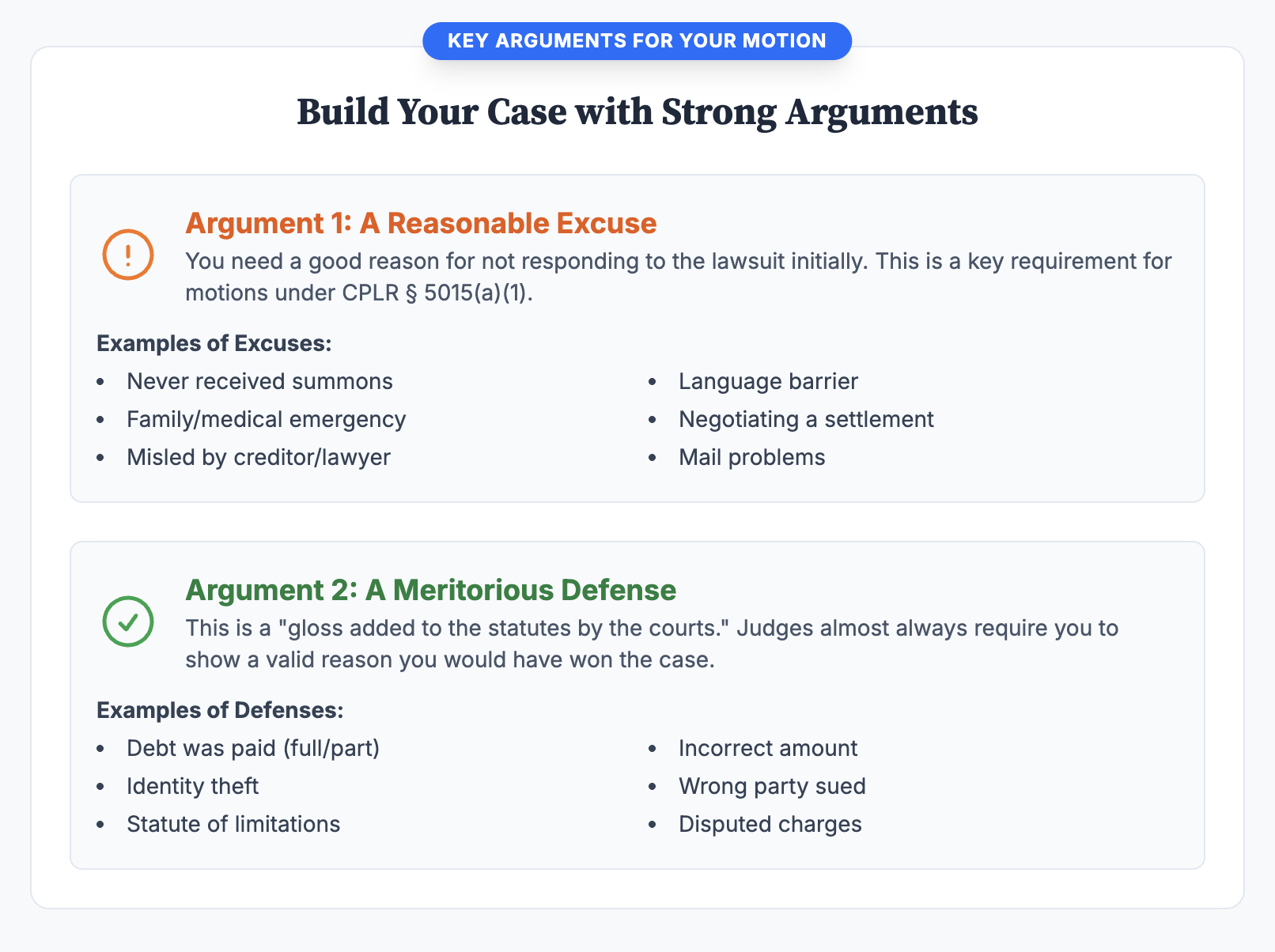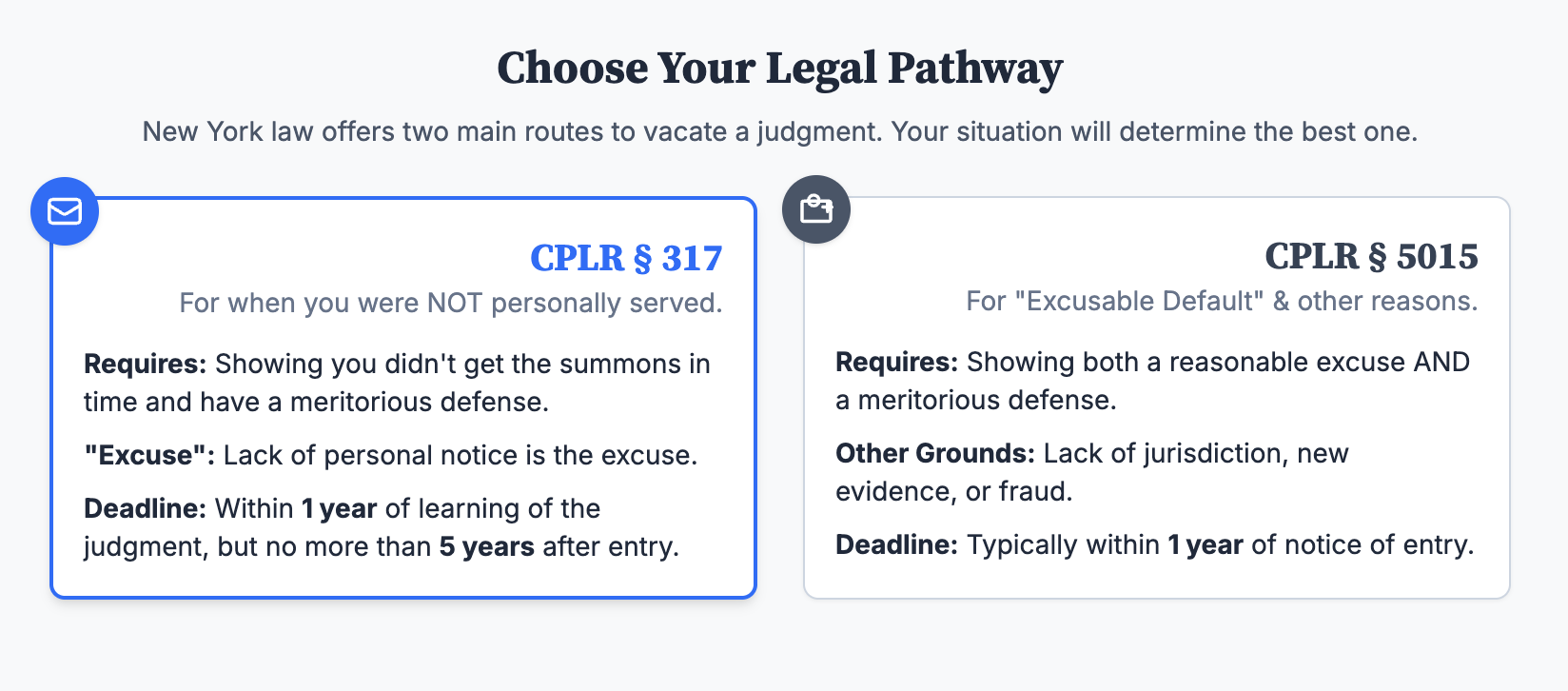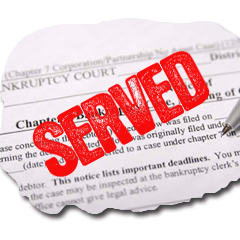Receive notice of a wage garnishment? Is your bank account frozen?

8 Points to Cover in Your Motion to Vacate a Default Judgment
- Although both statutes (CPLR §§ 5015 and 317) may not explicitly require showing a "meritorious defense," always raise as many defenses as possible to the underlying case. For example, did you pay all or part of the debt? Did you dispute the charges? Does a spouse owe it? Is it too old? Were you paying a settlement? Were you a victim of fraud or identity theft?
- Requiring a meritorious defense under both statutes is considered a "gloss added to the statutes by the courts."[1]
- Always provide a list of excuses and hardships for not defending your case. The more excuses, the better. You need to obtain leniency based on your excuses and hardships. See this blog post for a list of possible excuses.
- Time limits:
- Under CPLR § 317, you must move to vacate the judgment within one year of obtaining "knowledge of the entry of the judgment." Be specific about why you did not receive "knowledge" of the judgment until later. For example, did you move? Were you traveling?
- Under CPLR § 5015, a similar one-year deadline runs from when the plaintiff serves you a copy of the judgment with "written notice of its entry." This is harder to disprove if the plaintiff produces an affidavit of service showing such a mailing to your correct address. Produce all reasons you may not have received the mail.
- Courts have discretionary authority to extend these one-year deadlines.
- It helps to attack the sufficiency of the plaintiff's papers in your motion to vacate. Always try to obtain the court file and challenge all weaknesses in the file. Is the plaintiff's witness affidavit suspiciously vague, odd, or untrustworthy? If the case was brought after October 1, 2014, does the plaintiff have all the required affidavits discussed in this blog post, "New York Court Rules will Undoubtedly Impact Debt-Litigation Market"?
- Does the plaintiff's papers accurately reflect a "sum certain" as discussed in this blog, "Smart Way to Attack your Creditor's Default Judgment: The Sum Certain Element." In other words, does the creditor's evidence have holes that create ambiguity or uncertainty?
- Could you point to some kind of fraud (perjured affidavit, maybe) serving as the basis to vacate under CPLR § 5015(a)(3)? The lesson here is that good investigation and good arguments go a long way when challenging creditors' —especially debt buyers'—default judgments.
- Do not forget to simply ask the plaintiff's attorney to "stipulate" (agree) to vacate the judgment and allow you to answer the complaint. That is provided for under CPLR § 5015(b) below.
16 Examples of Defenses to Challenge a Default Judgment Under CPLR 5015
- Full or Partial Payment: The debt has been fully or partially settled, and evidence such as receipts or bank statements can prove this payment.
- Statute of Limitations (expiration of time): The creditor's time limit for filing a lawsuit for debt collection has expired, rendering the action untimely and unenforceable.
- Prior or Ongoing Dispute: A dispute over the debt or terms of the agreement has not been resolved, questioning the validity of the claim.
- Sued at the Wrong Address: The legal action was initiated using incorrect contact information, potentially violating procedural rules or due process rights.
- Incorrect Amount: The amount claimed is inaccurate, and documentation can prove the actual amount owed is less or null.
- Identity Theft: The debt was incurred by someone else using the defendant's identity fraudulently, not by the defendant.
- Wrong Party: The defendant is incorrectly identified as the debtor; the actual debtor is someone else.
- Unauthorized Changes: Changes to the account or contract were made without the defendant's knowledge or consent, affecting the debt's validity.
- Sudden Closure of Account: The creditor or bank closed the account unexpectedly without proper notification or justification.
- Inadequate Dispute Review: The creditor did not adequately review or address disputes raised by the defendant regarding the debt.
- Lack of Standing (No Prior Agreement or Relationship to Plaintiff/Creditor): The plaintiff has no legal right to sue because they have no legitimate connection or agreement with the defendant.
- Unfair or Abusive Collection Practices: The creditor engaged in practices that violate fair debt collection laws, potentially nullifying the lawsuit.
- Fraud by Family Member or Third Party, Including Forgery: The debt was incurred through fraudulent actions by someone known to the defendant or a third party without the defendant's consent.
- Fraud by Creditor or its Attorney: The creditor or their legal representation engaged in deceitful behavior in relation to the debt or lawsuit.
- Underage Party Lacking "Capacity" to Form a Contract: The defendant was underage and legally unable to enter into the contract that led to the debt, making it voidable.
- I Do Not Recognize this Debt | My Bills Were All Paid: The defendant does not acknowledge the debt as theirs, suggesting all obligations were previously settled.

If you need help, complete this intake form.

20 Examples of "Excuses" for Not Defending the Case
- Address Change | Lack of Notice: Change in address leading to not receiving the legal notice or summons.
- Clerical Errors by the Court (Lack of Notice): Mistakes made by the court's administrative staff resulting in failure to receive notice.
- Problems with Mail: Mail delivery issues, leading to non-receipt of court documents or notifications.
- Family Emergency: Urgent and unexpected family matters requiring immediate attention.
- Business Emergency: Sudden, critical situations affecting a business requiring the defendant's presence.
- Covid-19 Pandemic: Disruptions caused by the pandemic, including illness, quarantine, or other related issues.
- Financial Hardship: Financial difficulties prevent the defendant from responding effectively to the lawsuit.
- Prior Dispute Process: Engagement in a dispute resolution process that delayed the formal response to the lawsuit.
- Settlement Agreement or Settlement Discussions: Ongoing negotiations aiming to settle the matter out of court.
- Incorrect Information Provided to You: Misinformation given to the defendant regarding the lawsuit or procedural requirements.
- Work Obligations: Work commitments that hindered the defendant's ability to respond to the lawsuit.
- Physically Not Present in County, State, or United States: Absence from the jurisdiction due to travel or living abroad.
- False Statements Made by the Creditor or Lawyer (i.e., extensions of time): Misleading information from the opposing party affecting the response time.
- Ineffective Assistance of a Prior Attorney (i.e., reliance on bad advice): Poor legal representation or advice that led to the default.
- Misplaced Documents, including Summons or Court Notice: Loss of critical documents necessary for responding to the lawsuit.
- Medical Issue or Disability: Health problems affecting the defendant's ability to engage with the lawsuit.
- Medical Issue or Disability of Family Member: Caring for a family member with health issues, impacting the defendant's focus on the lawsuit.
- Language Barrier: Difficulty understanding the legal documents or process due to language differences.
- Unfamiliarity with the Legal Process: Lack of knowledge about legal procedures affecting the defendant's response.
- Incarceration: Being in jail or prison, making it challenging to address the lawsuit properly.
The Five Legal Bases to Vacate a Judgment under CPLR § 5015
Excusable default: Under NY CPLR 5015(a)(1), you can argue that the default was due to excusable neglect. This means you had a reasonable excuse for missing the deadline or not appearing. You will also need to demonstrate a meritorious defense of the action. The excuse for the default must be reasonable under the circumstances, such as an unexpected illness or an accident.
Lack of jurisdiction: Under NY CPLR 5015(a)(4), you can argue that the court didn't have personal jurisdiction over you. This could occur, for instance, if you were improperly served with the summons and complaint.
Newly Discovered Evidence: Under NY CPLR 5015(a)(2), you can argue that since the entry of a judgment, new evidence has been discovered which would probably change the outcome and which could not have been discovered in time to move for a new trial.
Fraud, misrepresentation, or other misconduct of an adverse party: Under NY CPLR 5015(a)(3), you can argue that the judgment was procured by fraud, misrepresentation, or other misconduct of the adverse party. For example, this could involve situations where the opposing party deliberately lied about a critical fact.
Reversal, modification or vacatur of a prior judgment or order: Under NY CPLR 5015(a)(5), you can argue that a prior judgment or order upon which the judgment is based has been reversed, vacated, or otherwise modified.
CPLR § 5015. Relief from judgment or order (Actual Text)
(a) On motion. The court which rendered a judgment or order may relieve a party from it upon such terms as may be just, on motion of any interested person with such notice as the court may direct, upon the ground of:
- excusable default, if such motion is made within one year after service of a copy of the judgment or order with written notice of its entry upon the moving party, or, if the moving party has entered the judgment or order, within one year after such entry; or
- newly-discovered evidence which, if introduced at the trial, would probably have produced a different result and which could not have been discovered in time to move for a new trial under section 4404; or
- fraud, misrepresentation, or other misconduct of an adverse party; or
- lack of jurisdiction to render the judgment or order; or
- reversal, modification or vacatur of a prior judgment or order upon which it is based.
(b) On stipulation. The clerk of the court may vacate a default judgment entered pursuant to section 3215 upon the filing with him of a stipulation of consent to such vacatur by the parties personally or by their attorneys.
(c) On application of an administrative judge. An administrative judge, upon a showing that default judgments were obtained by fraud, misrepresentation, illegality, unconscionability, lack of due service, violations of law, or other illegalities or where such default judgments were obtained in cases in which those defendants would be uniformly entitled to interpose a defense predicated upon but not limited to the foregoing defenses, and where such default judgments have been obtained in a number deemed sufficient by him to justify such action as set forth herein, and upon appropriate notice to counsel for the respective parties, or to the parties themselves, may bring a proceeding to relieve a party or parties from them upon such terms as may be just. The disposition of any proceeding so instituted shall be determined by a judge other than the administrative judge.
(d) Restitution. Where a judgment or order is set aside or vacated, the court may direct and enforce restitution in like manner and subject to the same conditions as where a judgment is reversed or modified on appeal.

§ 317. Defense by person to whom summons not personally delivered (Actual Text)
A person served with a summons other than by personal delivery to him or to his agent for service designated under rule 318, within or without the state, who does not appear may be allowed to defend the action within one year after he obtains knowledge of entry of the judgment, but in no event more than five years after such entry, upon a finding of the court that he did not personally receive notice of the summons in time to defend and has a meritorious defense. If the defense is successful, the court may direct and enforce restitution in the same manner and subject to the same conditions as where a judgment is reversed or modified on appeal. This section does not apply to an action for divorce, annulment or partition.
The Differences Between CPLR § 5015 and § 317
In New York, there are two primary legal pathways for vacating a default judgment when a defendant fails to appear in court: CPLR 5015(a)(1) and CPLR 317. While both require the defendant to show they have a valid defense, they differ in other requirements.
CPLR 5015(a)(1) necessitates a reasonable excuse for the absence, whereas CPLR 317 simply requires demonstrating lack of notice about the lawsuit due to alternate service methods, such as through the Secretary of State for corporations. For CPLR 317, the motion to vacate must be made within one year of learning about the judgment but not more than five years after its entry. Moreover, if the method of service is in question, CPLR 317 may provide a more lenient route for vacating the default.
Case Holdings for Reference:
- CPLR 5015(a)(1) and 317 require a potentially meritorious defense: Progressive Casualty Insurance Co. v. Excel Products, Inc., 171 A.D.3d 812, 98 N.Y.S.3d 87 (2nd Dep't 2019).
- Under CPLR 317, the defendant must not have received notice of the suit for the default to be vacated: HSBC Bank USA, N.A. v. Eliyahu, 170 A.D.3d 1130, 97 N.Y.S.3d 259 (2nd Dep't. 2019).
- A mere denial of receipt of the summons and complaint is insufficient for CPLR 317: Dwyer Agency of Mahopac, LLC v. Dring Holding Corp., 164 A.D.3d 1214, 82 N.Y.S.3d 118 (2nd Dep't 2018).
- The Secretary of State is not considered an “agent” for CPLR 317 purposes: Eugene Di Lorenzo, Inc. v. A.C. Dutton Lumber Co., Inc., 67 N.Y.2d 138, 501 N.Y.S.2d 8, 492 N.E.2d 116 (1986); Acqua Capital, LLC v. Camarella Contracting Co., Inc., 164 A.D.3d 1197, 82 N.Y.S.3d 122 (2nd Dep't 2018).
- Deliberate avoidance of notice disqualifies a corporation from CPLR 317 relief: Pina v. Jobar, 104 A.D.3d 544, 961 N.Y.S.2d 150 (1st Dep't 2013).
- Courts may treat motions as made under the appropriate statute regardless of citation: Eugene Di Lorenzo, Inc. v. A.C. Dutton Lumber Co., Inc., supra.
- CPLR 5015(a)(4) cannot be applied sua sponte if lack of jurisdiction is claimed: Caba v. Rai, 63 A.D.3d 578, 882 N.Y.S.2d 56 (1st Dep't 2009).
By understanding these statutes and the relevant case law, parties can better navigate the process of contesting default judgments. Whether through CPLR 5015 or CPLR 317, presenting a solid defense and proving lack of proper notice are key to vacating a default judgment.
Failure to Seek Default Judgment Within One Year Leads to Dismissal of Complaint as Abandoned
In this personal injury case arising from a motor vehicle accident, the plaintiff failed to take proceedings for entry of default judgment within one year after the defendant's default. More than four years after serving the summons and complaint, the plaintiff attempted to justify the delay by citing the death of her attorney. The court rejected this excuse and dismissed the complaint as abandoned under CPLR 3215(c).
Key Legal Principles:
- CPLR 3215(c) mandates dismissal of a complaint if the plaintiff fails to seek entry of default judgment within one year, unless sufficient cause is shown.
- To avoid dismissal, a plaintiff must demonstrate both a reasonable excuse for the delay and a potentially meritorious action.
- An attorney's death occurring after the one-year statutory period has expired does not constitute a reasonable excuse for failing to seek a default judgment.
Conclusion: This case underscores the importance of diligently pursuing default judgments within the statutory timeframe. Plaintiffs cannot rely on events occurring after the one-year period has expired to justify their delay. The main takeaway is that courts will strictly enforce the one-year deadline for seeking default judgments under CPLR 3215(c).
Citation: Myoung Ja Kim v Wilson, 150 AD3d 1019 (2d Dept 2017).
Default Judgment Denied Due to Insufficient Proof and Untimely Filing Under CPLR 3215
A mortgage lender sought to impose an equitable mortgage on real property and moved for default judgment under CPLR 3215. The court denied the motions because the plaintiff failed to submit proof of service of the summons and complaint as required by CPLR 3215(f), and filed more than one year after the defendants' default without showing reasonable excuse for the delay under CPLR 3215(c).
Key Legal Principles:
- Under CPLR 3215(f), a party moving for default judgment must submit proof of service, proof of facts constituting the claim, and proof of defendant's failure to appear or answer.
- Per CPLR 3215(f) and CPLR 3020(d)(3), a verified complaint used as an affidavit must contain evidentiary facts from someone with personal knowledge; verification by an attorney is insufficient.
- Under CPLR 3215(c), default judgment motions made more than one year after default require both reasonable excuse for delay and showing of potential merit.
Conclusion: The case establishes strict interpretation of CPLR 3215's requirements for default judgments, particularly regarding proper service documentation and timely filing, while clarifying that attorney verification alone cannot establish merit.
Citation: DLJ Mortgage Capital, Inc. v United General Title Insurance Co., 128 AD3d 760 (2d Dept 2015).
Related Links:
- Receive a Notice of Garnishment? Here’s a Summary of New York Law
- How much of my wages can be garnished? Summary of New York Law
[1] Barone v. Barone, 54 Misc. 3d 599 (Sup. Ct., Monroe County 2016).


